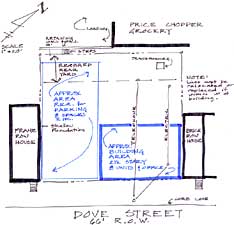Why is this step important?
In most cases, getting the right site is the single most important step in the affordable housing development process. Sometimes an available site simply won't work for the project the developers have in mind, but would be well-suited to an entirely different purpose or user group. Sometimes the site is difficult, but good design can make it work. And sometimes the site will not be suitable for a development at all, and enormous amounts of effort and resources can be saved and devoted elsewhere. More about the Importance of Site Analysis.
When should this step be done?
Who should do this step?
The owner/developer with assistance from an architect or other experienced development professional.
What should be done?
How can doing this help move my project forward?
- Being sure that the project fits its site - physically and contextually - helps avoid downstream problems that could force a complete rethinking of project after considerable upfront development resources have already been expended.
- A clear demonstration that the project will work on the proposed site will improve the credibility of the project during the early stages of development.
- The unit count/mix developed during the Site Suitability Test can feed directly into the feasibility study for the project.
Importance of Site Analysis - Expanded Narrative
A site which cannot physically handle its projected density and use, or one which will be intrinsically costly to develop, will fail to "pencil out" financially, requiring either a radical rethinking of the project or abandoning the site. Likewise a site hampered by regulatory constraints may prove unfeasible. It is critical to identify such limitations as early as possible in the development process, before valuable time and resources have been spent on a site that may not be appropriate.
Too often the sites available for affordable housing are marginal, "leftover" sites that are, for various reasons, unattractive to for-profit developers. This means that the sites may be inherently difficult to develop. All the more reason for the type and amount of housing proposed to closely match the physical capabilities of the site.
In addition, even if a site "works" physically it must also be located so as to provide easy access to the amenities and services its occupants will require. If the project seeks to house working families, then access to transportation, jobs, schools and shopping is critical. If it is a project for the elderly, access to jobs and schools may be much less important than being located near a park that is perceived to be safe and secure. If such user-specific amenities and services are lacking - or are too far away to be accessible - the project will encounter problems attracting and retaining tenants or buyers.
Finally, even if a site can physically accommodate the uses and density proposed for it - and provide adequate access to the services its occupants will need - the development itself must also "fit" with the neighborhood into which it is being placed. For example, locating an elderly housing project on an isolated site near a light commercial district would be a mistake, even if the land were free. Inappropriate uses and/or densities can generate political opposition to the project, and the wrong project in the wrong location may never succeed financially. Both good reasons to ensure - as early in the process as possible - that proposed use and density "fit" the site's neighborhood.
Additional Resources
For additional information on basic site analysis, consult:
Architectural Graphic Standards published by John Wiley & Sons, or
Time-Saver Standards for Housing and Residential Development, published by McGraw-Hill.
Contact points:
www.wiley.com
www.mcgraw-hill.com
For a thorough guide to current Federal requirements for universal access - together with information on other, voluntary accessibility design tools - please refer to the resources in HUD's Office of Fair Housing and Equal Opportunity at www.hud.gov/fairhousing
